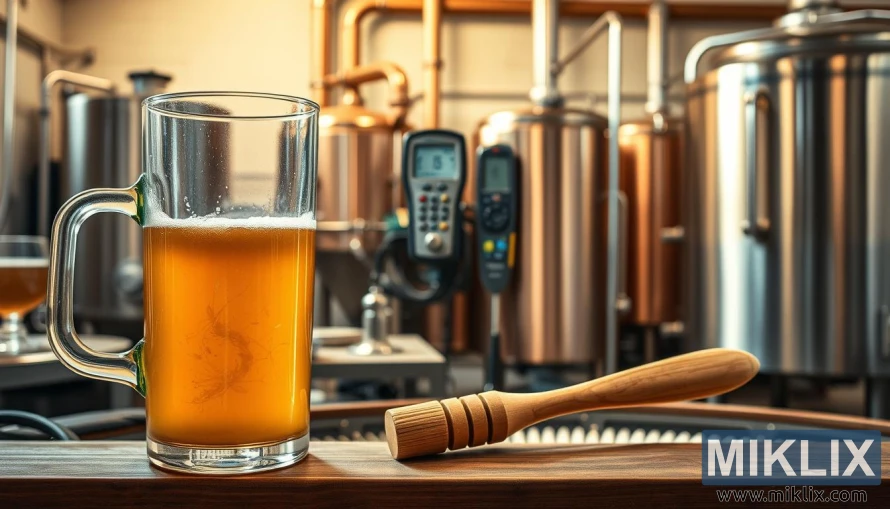Image: Oat Beta-Glucan Rest Mashing Technique
Published: July 23, 2025 at 6:23:42 AM UTC
Last updated: September 27, 2025 at 5:25:40 PM UTC
A detailed view of oat beta-glucan mashing with golden wort and brewing tools, highlighting craftsmanship and precise brewing.
In this richly textured scene, the image captures a moment of quiet precision and artisanal care within a professional brewing environment. The foreground draws immediate attention to a clear glass mug filled with a light amber beer, its surface crowned with a delicate layer of foam that clings to the rim in soft, creamy swirls. The beer glows under the ambient lighting, its clarity and color suggesting a well-balanced brew—perhaps one that has undergone a traditional beta-glucan rest during mashing, a technique often employed when working with oat-based adjuncts to enhance mouthfeel and stability. The mug rests on a wooden surface, its rustic grain adding warmth and grounding the composition in a tactile, handcrafted aesthetic.
Beside the glass, a wooden-handled brush lies casually, hinting at the behind-the-scenes labor that defines the brewing process. Whether used for cleaning equipment or stirring mash, its presence reinforces the hands-on nature of the craft. It’s a subtle nod to the brewer’s role—not just as technician, but as caretaker of every stage, from sanitation to fermentation. The brush’s worn bristles and smooth handle speak to repeated use, to the rhythm of brewing days and the quiet rituals that accompany them.
In the middle ground, the image opens into a well-organized brewhouse, where stainless steel fermentation tanks rise like polished pillars. Their surfaces gleam under the soft lighting, reflecting the surrounding equipment and casting gentle highlights that suggest cleanliness and precision. Pipes and control panels weave through the space, forming a network of functionality that supports the brewing process. Digital instruments blink quietly, monitoring temperature, pressure, and flow—each one a guardian of consistency and quality. The layout is efficient yet inviting, designed for both productivity and contemplation.
The background, though slightly blurred, reveals the scale and sophistication of the facility. Large brewkettles, possibly copper-clad, anchor the space with their traditional silhouette, while modern fermentation vessels stand in contrast, embodying the fusion of old-world techniques and contemporary technology. The lighting here is dimmer, more atmospheric, casting long shadows and creating a sense of depth and mystery. It’s a space that feels alive with potential, where every tank holds a story in progress, every valve a decision waiting to be made.
Together, the elements of this image tell a story of brewing as both science and art. The glass of beer in the foreground is not just a finished product—it’s a culmination of choices, from grain selection to mash temperature, from beta-glucan rest to fermentation control. The presence of oats, implied through the creamy texture and golden hue, suggests a deliberate effort to craft a beer with smoothness and body, qualities that require patience and understanding. The equipment, the lighting, the composition—all reinforce the idea that brewing is a dialogue between tradition and innovation, between the brewer and the brew.
This is not merely a snapshot of a brewery—it’s a portrait of dedication. It honors the quiet moments of observation, the subtle adjustments, and the deep knowledge required to transform raw ingredients into something memorable. The image invites the viewer to appreciate the complexity behind a single glass of beer, to see the beauty in the process, and to recognize the craftsmanship that defines the best of brewing.
The image is related to: Using Oats as an Adjunct in Beer Brewing

